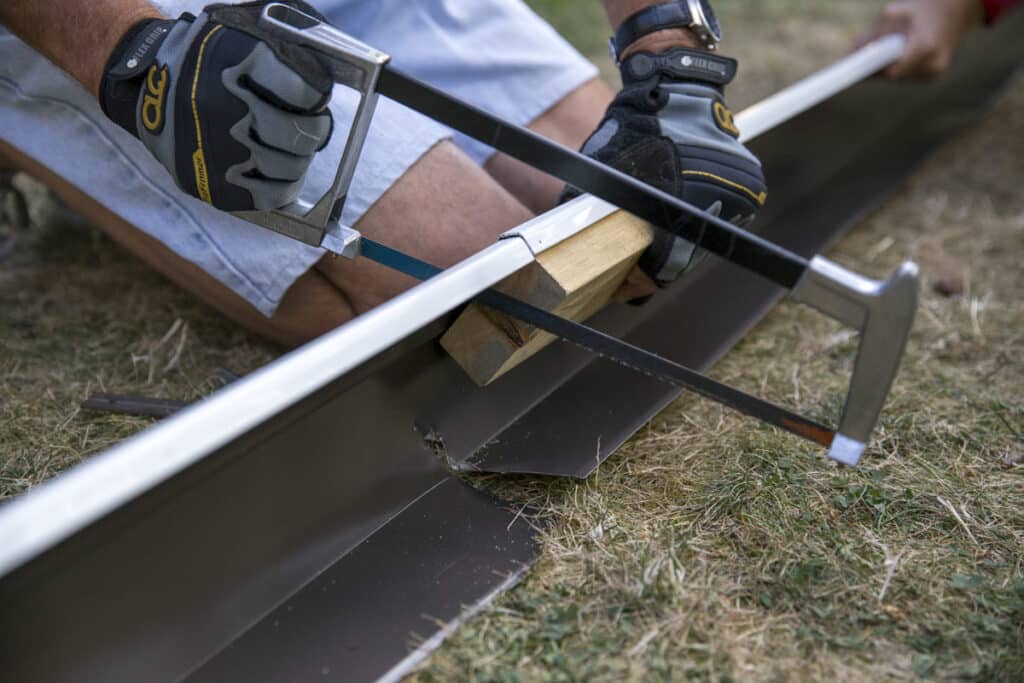
Gutters prevent costly water damage by funneling rainfall away from a home. If gutters become damaged, mud can erode exterior materials and discolor the siding.
To cut metal rain gutters, you can use a hacksaw or tin snips. Before cutting, you must disconnect the downspouts by removing nails or screws. Once your cuts are complete, smooth down rough spots with a metal file.
Tools
Gutter systems are typically made from aluminum, copper, or steel. Some are also made from vinyl (PVC). The materials are fairly easy to cut, although the task is labor intensive and requires a fair amount of physical strength. Using the proper tools and techniques will help you achieve clean, smooth cuts that will ensure the gutters fit together snugly without gaps or crinkles.
The most commonly used tool for cutting metal gutters is a pair of tin snips, though you can also use hacksaws or jigsaws that are equipped with a metal-cutting blade. These tools are effective when working with standard aluminum gutters, but they may not be suitable for other types of metal gutters or if you’re installing them on a home made of galvanized steel.
If you’re planning on installing gutters, it’s a good idea to invest in an angle grinder with a cutting disc that’s specifically designed for aluminum. These discs have fine abrasives and bonding agents that prevent the aluminum from clogging or overheating during cutting. Using this tool will help you avoid the headaches and frustration that often accompany manually cutting gutter sections with tin snips or other hand tools. To get started, secure the gutter section on a table or work surface. Measure the length you need to cut with a tape measure and mark it with a pencil. Put on work gloves and eye protection to protect yourself from dust and jagged edges as you cut.
Safety
Taking the right safety measures is vital when cutting metal gutters. This step of the process is an essential precursor to ensuring a precise and tailored fit for the gutter section, thereby increasing the performance of your home’s rainwater system.
Ideally, you should always double-check your measurements and carefully plan out the layout of your new gutter sections. This will help you avoid errors such as insufficient gaps, crinkling, and bending of the gutter, which could compromise its functionality. Additionally, you should wear protective gloves and safety glasses to shield your eyes from debris and sharp edges during the cutting and installation process. It’s also a good idea to secure the gutter or downspout section on sawhorses or a work surface for stability and control.
The type of cutting tool you choose should be based on the material of your gutters and your level of proficiency with different tools. Generally, you can use either electric or manual tin snips for aluminum gutters, while hacksaws and miter saws equipped with a metal-cutting blade are more suited to steel and zinc gutters.
Regardless of the chosen cutting tool, it’s important to use light and consistent pressure during the cutting process. Doing otherwise could result in cracking and bending of the aluminum, which may compromise its structural integrity. Similarly, using too much force may cause the cutter to overheat and dull its blade, which can compromise your cutting efficiency.
Preparation
You may have to use your hands and arms to maneuver a metal cutting blade while working with gutters. For this reason, you should wear gloves to protect your skin and safety glasses to protect your eyes. You also need a stable ladder to work from, as well as a sturdy platform or scaffolding if you’re using a height-adjustable ladder. Before you cut the gutters, measure your home’s roof line or the length of your existing gutters to determine the dimensions you need for the new system.
Once you’ve made all the necessary cuts, smooth down any rough edges with a metal file or sandpaper. This will prevent injuries during installation when you’re attaching end caps, sealing joints, joining pieces together and moving the gutters around your house.
If you’re planning to paint your gutters, sand the metal with a low-grit sandpaper and apply a coat of primer before you proceed. If you choose to use an oil-based primer, make sure it’s formulated for metal. Allow the primer to dry completely before you begin painting. You may also want to use a high-quality sprayer to apply the top coat, but only if you’re using an oil-based paint. Otherwise, you’ll have to use a paintbrush and take the time to allow each coat to dry. Once the top coat is dry, you can put your gutters back up.
Cutting
If you are unable or unwilling to cut metal gutters yourself, you can still hire a professional to do it for you. They can be installed correctly to prevent water damage and help your home stay safe and dry.
You should wear a pair of protective gloves and safety goggles while working with metal shears to protect yourself from cuts and scrapes. The cutting process is fairly simple, but it can be time-consuming and requires a fair amount of physical strength.
Once you have the right tool, start by marking a line where you want to cut with a combination square. Make sure that the line is straight and perpendicular to the gutter section.
Use tin snips to cut the gutter sections. These handheld tools are easy to use and can be used for a variety of different tasks, including cutting sheet metal, gutters, studs, and metal roofing. They can also cut curves and circles if you hold the blades in the same position as you would a pair of scissors.
Tin snips are the most common handheld tools for cutting aluminum gutters, but you can also use hacksaws or jigsaws (provided that they have a metal-cutting blade). You may find that it is easier to work with thinner aluminum gutters than thicker ones since heavy metal tends to crinkle and bend when cut. After you have made all the necessary cuts, be sure to smooth down any rough edges using a file or sandpaper. This helps to prevent injury when attaching end caps, sealing joints, joining pieces, or moving the gutters around during installation.






























